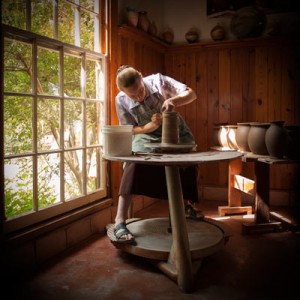Managing potter, Jenni Fritzlan, has been making pottery for nearly twenty years later. She consistently produces high-end ceramics in a number of different styles. As an instructor for The Ploughshare Institute, Jenni teaches a variety of pottery classes throughout much of the year and oversees the staff of potters at The Potter’s House. Jenni has recently begun focusing her efforts on mastering an ancient Japanese style of pottery known as Raku and has also been experimenting with custom teapots for Cafe Homestead. For a more in-depth look at Jenni’s journey in pottery read this interview.
— Jenni Fritzlan
About Homestead Pottery
The Potter’s  House, also known as Homestead Pottery, originated as part of the Homestead Heritage community’s broader efforts to restore, use and teach traditional craft skills. The shop is located in Homestead Craft Village, along with other artisan shops and is open daily.
House, also known as Homestead Pottery, originated as part of the Homestead Heritage community’s broader efforts to restore, use and teach traditional craft skills. The shop is located in Homestead Craft Village, along with other artisan shops and is open daily.
Stop by to watch our skilled craftsmen shape beautiful pieces of pottery by hand using traditional, time-tested methods. Our potters will be happy to answer your questions while they work, and more than one visitor has found himself sitting at the wheel receiving an impromptu pottery lesson. If you desire more formal instruction, we also offer a variety of pottery classes through the Ploughshare Institute for Sustainable Culture.
Browse our many shelves of finished and in-process pottery. View hundreds of pieces of varying shape, size and color and gain an appreciation for the distinct beauty that is imparted by the ancient practice of finishing pieces in a wood-fired kiln. Bring a piece home or give it as a gift. The heirloom quality and unique aesthetics of these items make each piece a special part of any home.
Ancient Pottery
From the beginning of recorded history, pottery has played an important role in society. Archaeologists say that clay pots were some of the first items used for food storage. Clay jars have long been used both to store and serve water. Many types of clay ovens continue to be used around the world for preparing meals. The availability of clay in nearly all parts of the world, as well as its outstanding versatility and durability, have made pottery an indispensable part of nearly every known culture.
Pottery in Early America
The end of the American Revolution in 1783 marked an interesting time in the development of American pottery. Until then, the British had enacted a fairly strict policy which prohibited Americans from manufacturing anything beyond very basic forms of pottery, such as chamber pots, pans and common kitchen items. Finer items had to be imported from England.
After the American Revolution, domestic pottery production in the United States began to increase. The primary production of pottery occurred in the more densely populated urban areas. However, in rural areas, where daily labors were less specialized, farmers would often take up pottery during months of the year when the demands were lower in the fields.
Industrial Revolution
Like many other traditional crafts, pottery was a start to finish process — that is, a single craftsman would do all of the processes on a piece of pottery. With the onset of the Industrial Revolution, the mindset of the nation began to shift towards mass production models.
In England, Josiah Wedgwood had become well known for his ceramics assembly line, and in this new industrial model, every potter did one step of the process, over and over. They soon became very fast at doing their given task, as did their fellow laborers, and the production efficiency of the factory rose drastically. Manufacturers in America would quickly, in turn, adopt Wedgwood’s model. Eventually, most industrial pottery operations would forego the use of the traditional potters’ wheel in lieu of shaping objects on large presses using mass-produced molds. This triumph of economic efficiency dealt a devastating blow to the beauty of this traditional craft and to those who had labored to keep it alive over the generations.
As the 20th century progressed, even most of the factory pottery jobs in the United States would dry up, as labor, itself, became a mere commodity that found a fertile and inexpensive market overseas.
Pottery Today
Inexpensive ceramic imports abound, and steel, glass and other synthetics have largely taken the place of pottery in many domestic uses. But as with many other traditional crafts over the last few decades, a revival of interest has begun.
Here, in the Homestead Craft Village, Homestead Pottery meets the growing desire of many who seek higher quality work of enduring value, and who have a special appreciation for those things which are crafted with skill and care and that are as beautiful as they are unique.